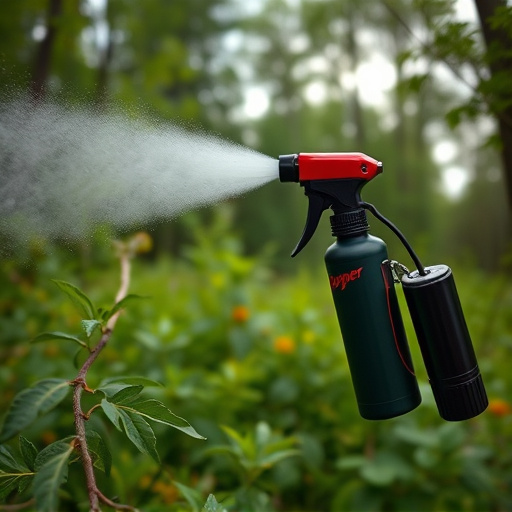Maintain pepper spray effectiveness by storing it between 50-70°F (10-21°C). Avoid extreme heat or cold, direct sunlight, and moisture to prevent degradation of active ingredients, especially capsaicin. Follow manufacturer guidelines for optimal storage and regular maintenance, including expiration dates and alarm/lock features.
In today’s unpredictable world, civilian protection tools like defensive spray are gaining prominence as viable self-defense options. This comprehensive guide delves into the effectiveness of pepper spray in civil protection, navigating legal considerations for its use, and factors crucial to optimal storage—including the best storage temperature for pepper spray. We explore different types suitable for personal safety and best practices for storage and maintenance, empowering individuals with knowledge for enhanced security.
- Understanding Pepper Spray's Effectiveness in Civil Protection
- Legal Considerations for Civilian Self-Defense Spray Use
- Factors Influencing Optimal Storage Temperature for Pepper Spray
- Choosing the Right Type of Pepper Spray for Personal Safety
- Best Practices for Storing and Maintaining Your Defensive Spray
Understanding Pepper Spray's Effectiveness in Civil Protection
Pepper spray, a popular choice for civilian protection, has established itself as an effective tool in deterring potential attackers. Its active ingredient, capsaicin, is derived from chili peppers and stimulates the nervous system, causing temporary disorientation and pain. This disruption significantly increases the victim’s chances of escaping or seeking help.
When considering its effectiveness, understanding the best storage temperature for pepper spray is crucial. Pepper spray should be stored in a cool, dry place, typically between 50-70°F (10-21°C). Maintaining this optimal range ensures the potency and functionality remain intact, as extreme temperatures can degrade the spray’s chemical composition. Proper storage extends the lifespan of pepper spray, making it a reliable option for personal safety.
Legal Considerations for Civilian Self-Defense Spray Use
When considering civilian self-defense spray, understanding legal considerations is paramount. Each jurisdiction has specific laws and regulations regarding the use, possession, and storage of pepper spray or other self-defense aerosols. In many areas, civilians are permitted to carry and use these devices for personal protection, but restrictions apply. For instance, some regions mandate minimum age requirements, while others have rules about where and how the spray can be deployed.
Proper storage is another critical aspect, especially regarding the best storage temperature for pepper spray. Most manufacturers recommend storing self-defense sprays in a cool, dry place, typically between 50°F to 70°F (10°C to 21°C). Extreme temperatures can affect the spray’s effectiveness and stability, so it’s essential to follow these guidelines to ensure optimal performance when needed.
Factors Influencing Optimal Storage Temperature for Pepper Spray
The optimal storage temperature for pepper spray is a crucial factor in maintaining its effectiveness and potency. Generally, most manufacturers recommend storing defensive spray at temperatures between 50°F to 70°F (10°C to 21°C). However, these guidelines can vary slightly depending on the specific formula and ingredients used. Extreme fluctuations or prolonged exposure to high heat or cold can impact the chemical composition of pepper spray, potentially reducing its performance when needed most.
Several key considerations influence this ideal range. First, heat can accelerate the breakdown of capsaicin, the active ingredient responsible for the burning sensation associated with pepper spray. Second, cold temperatures may cause the solution to thicken or solidify, affecting its dispersion and potency during use. Thus, maintaining a consistent, moderate temperature ensures that civilian protection sprays remain potent, ready, and effective when deployed in emergency situations.
Choosing the Right Type of Pepper Spray for Personal Safety
When considering pepper spray as a personal safety measure, choosing the right type is paramount. Opting for a spray with a high capsaicin concentration ensures its effectiveness against potential threats. Active ingredients, delivery mechanisms, and can size are key factors to consider. Look for sprays designed specifically for civilian protection, offering a balanced force that incapacitates without causing long-term harm.
Proper storage is equally vital for maintaining the spray’s potency. The best storage temperature for pepper spray typically ranges between 50°F (10°C) and 70°F (21°C). Extreme temperatures can degrade the active ingredients, reducing its effectiveness. Store your pepper spray in a cool, dry place, away from direct sunlight, heat sources, or freezing conditions to ensure it remains ready when you need it most.
Best Practices for Storing and Maintaining Your Defensive Spray
To ensure your defensive spray remains effective, proper storage and maintenance are paramount. The best practice is to store it in a cool, dry place with a temperature between 50-70°F (10-21°C). Extreme heat or cold can degrade the active ingredients, reducing its potency. Avoid storing it near direct sunlight or sources of excessive moisture to prevent any potential damage.
Regularly inspect your spray for any signs of damage or corrosion. Keep it sealed tightly when not in use and out of reach of children or unauthorized individuals. Some models come with a built-in alarm or lock mechanism, which can be activated during storage to deter unauthorized access. Regular maintenance includes checking the expiration date and replacing the device as needed, per manufacturer recommendations.
Defensive spray has emerged as a powerful tool for civilian protection, offering swift and effective deterrence in potentially dangerous situations. By understanding its effectiveness, navigating legal considerations, and implementing best practices for storage and maintenance, individuals can ensure they have a reliable means of self-defense. Moreover, recognizing the optimal storage temperature for pepper spray is key to preserving its potency. Ultimately, choosing the right type of defensive spray, combined with proper care, allows civilians to protect themselves with confidence in today’s diverse and dynamic world. Remember that maintaining the best storage temperature for pepper spray is a game-changer in maximizing its potential as a vital self-defense tool.
